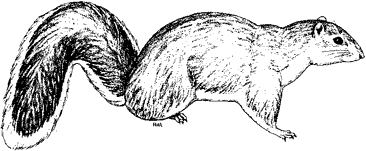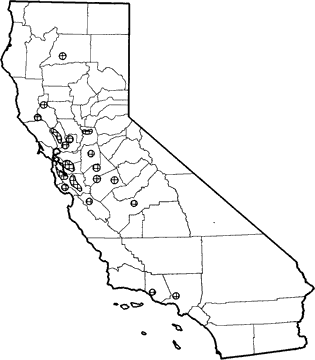
Eastern Fox Squirrel
Distribution, Abundance, and Seasonality
The eastern fox squirrel is an introduced species with many localized populations in urban areas and nearby rural settings. Reported from San Mateo, Merced, and Ventura cos. (Ingles 1965, Wolf and Roest 1971), and Santa Clara and Santa Cruz cos. (Gilroy 1980). Also believed to occur in Shasta and Los Angeles cos., and from Lake Co. south to San Benito and Fresno cos., west of the Sierra Nevada foothills. The eastern fox squirrel is common in urban and orchard-vineyard habitats, and in eucalyptus groves. Individuals are moving into the edges of valley foothill riparian, redwood, and valley foothill hardwood habitats in Santa Cruz Co. (Gilroy 1980), and possibly elsewhere.

Range Map
Specific Habitat Requirements
Feeding: The eastern fox squirrel eats acorns and a wide variety of other nuts, fruits, and seeds. In Ventura Co., eats wild and domestic agricultural nuts and fruits in summer, eucalyptus seeds in winter (Wolf and Roest 1971, Flyger and Gates 1982).
Cover: Uses trees for cover, keeping the tree between squirrel and predator or disturbance. Often remains motionless in order to avoid detection (Flyger and Gates 1982).
Reproduction: Uses tree cavity; hollow spheres of leaves also constructed on tree limbs or in the crotches of trees, 8-20 m (26-66 ft) above the ground.
Water: Obtains water from plant food. Drought may cause high mortality (Flyger and Gates 1982).
Pattern: Prefers open forests, forest edges, orchard-vineyard, riparian, and urban habitats. In Ventura Co., uses eucalyptus groves in winter, and moves to orchards and native habitats in spring and summer (Wolf and Roest 1971). In Santa Clara Co., preferred trees with larger basal diameters than gray squirrels; neither species used large eucalyptus (Gilroy 1980). Populations dependent upon abundant mast crops.
Species Life History
Activity Patterns: Yearlong diurnal activity.
Seasonal Movements / Migration: None reported in California, though large-scale movements occasionally have been reported elsewhere (Flyger and Gates 1982).
Home Range: Home ranges vary from 0.4-16.4 ha (1- 41 ac) (Flyger and Gates 1982). Individuals in poor habitat, or in areas of low food abundance or low population density, tend to have larger home ranges. Males have larger home ranges than females. Home ranges may shift to include good food sources. Densities fluctuate irregularly, varying from 0.5-3.5 per ha (0.2-1.4 per ac) (Flyger and Gates 1982). Wolf and Roest (1971) found an average of 0.77 per 100 m (0.85 per 300 ft) in windrow eucalyptus.
Territory: At high densities, may be territorial. At low densities, individuals scattered and home ranges may overlap. Females defend the nest area from other squirrels. A dominance hierarchy controls mating, access to food sources, and access to den sites (Flyger and Gates 1982). Several squirrels may share winter dens.
Reproduction: May breed in any month in California. Mating begins in December over a wide range of latitudes elsewhere (Moore 1957) and continues to February, followed by a second mating period in June. Gestation lasts 44-45 days. Births begin in January, with most births in mid-March and July. Litter size from several studies averaged 3, with 2 litters per yr (Flyger and Gates 1982). Yearlings may produce only 1 litter. The young are altricial and, though they are weaned in 8-9 wk, are not self-sufficient until 12 wk of age. Sexual maturity is reached at 10 mo for males and females. Fox squirrels live to 13 yr in captivity, and have been reported to live past 6 yr of age in the wild.
Niche: The fox squirrel generally is restricted to areas of human habitation in California, but may be sympatric in some areas with the western gray squirrel. Predation is not a major source of mortality for most eastern populations, although Fritts and Sealander (1978b) reported that bobcat diets were 24% fox and gray squirrel (Flyger and Gates 1982). Severe winter weather, drought, food shortage, and combinations of these factors with mange, are major causes of mortality in eastern populations.
Sources & References
California Department of Fish and Game, 1999.
California's Wildlife, Sacramento, CA.
Written by: G. Hoefler, J. Harris, reviewed by: H. Shellhammer, edited by: R. Duke, S. Granholm
Allen, D. L. 1943. Michigan fox squirrel management. Mich. Dep. Cons., Game Div. Publ. No. 100. 404pp. Baumgartner, L. L. 1940. The fox squirrel: its life history, habits, and management in Ohio. Ohio State Univ. Wildl. Res. Sta. Release No. 138. 257pp. Byrne, S. 1979. The distribution and ecology of the non-native tree squirrels Sciurus carolinensis and Sciurus niger in northern California. Ph.D. Thesis, Univ. Calif., Berkeley. 190pp. Flyger, V., and J. E. Gates. 1982. Fox and gray squirrels. Pages 209-229 in J. A. Chapman and G. A. Feldhamer, eds. Wild mammals of North America. Johns Hopkins Univ. Press, Baltimore, MD 1147pp. Fritts, S. H., and J. A. Sealander. 1978b. Diets of bobcats in Arkansas with special reference to age and sex differences. J. Wildl. Manage. 42:533-539. Gilroy, A. M. 1980. Habitat analysis of Sciurus niger and Sciurus carolinensis in the Santa Cruz Mountains of California. M.A. Thesis, San Jose Univ., San Jose. 33pp. Ingles, L. G. 1965. Mammals of the Pacific states. Stanford Univ. Press, Stanford, CA. 506pp. Moore, J. C. 1957. The natural history of the fox squirrel, Sciurus niger shermani. Bull. Am. Mus. Nat. Hist. 113:1-71. Short, H. C. 1976. Composition and squirrel use of acorns of black and white oak groups. J. Wildl. Manage. 40:479-483. Smith, C. C., and D. Follmer. 1972. Food preferences of squirrels. Ecology 53:82-91. Wolf, T. F., and A. I. Roest. 1971. The fox squirrel (Sciurus niger) in Ventura County. Calif. Fish and Game 57:219-220.
California Animal Facts | California's Wildlife